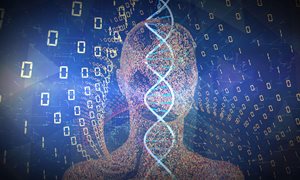
The Center of Molecular and Biomolecular Informatics (CMBI) is leading research on bridging artificial intelligence (AI) and 3D modelling of protein structures. Recently, on 3 December 2021, Li Xue et al., theme Cancer development and immune defence, published DeepRank, a deep learning framework for data mining 3D protein-protein structures, in Nature Communications and GitHub. DeepRank makes deep learning (DL) accessible for broad biochemists and life scientists.
What can it be used for?
DeepRank provides an easy DL platform; researchers come up with their own research questions related with 3D protein structures. DeepRank takes 3D protein-protein structures as input, and outputs a prediction. The output of DeepRank is defined based on the users’ research question and their training data. For example, how two proteins interact with each other in 3D space and where do they interact (i.e., which part of a protein interacts with which part of another protein)? Whether a mutation is disease-causing or not? Is the protein-protein interaction that we observe in X-ray experiments a biological interaction or crystal artefacts? And many many more.
_1.png.aspx?width=400&height=400)
Image: illustration of DeepRank
Protein functions are encoded in their 3D shapes. In the past decades, a number of imaging techniques were developed (e.g., X-ray, NMR, Cryo-EM) and a large number of experimentally determined 3D protein structures have been accumulated. A human expert trained for 30+ years could excruciatingly examine them by eyes as the spatial arrangement of atom pairs and interactions shed light on the secrets of biological life. However, human inspection is not efficient. And the relationship between 3D structures of diverse proteins and their functions is too intricate to be even mastered by human experts.
Using quantitative statistical approach to approximate/simulate human perception was visioned and pioneered by Frank Rosenblatt, a psychologist, in 1958. After a half-century, this dream finally came true recently when deep learning achieved human-level accuracy in 2D image perceptions. However, such breakthroughs did not naturally translate to molecular biology.
DeepRank aims to facilitate such translations. Removing daunting phases of data preprocessing on millions of structures, DeepRank allows a user to easily train a 3D-CNN to scan protein structures for desired patterns and make predictions. In the paper, they showcase the effectiveness of DeepRank on two distinct applications in structural biology.

Image: Xue's lab logo showing their research theme: AI-boosted 3D modeling
Potential applications are wide. Xue’s lab is using DeepRank to aid cancer vaccine design. CMBI is extending DeepRank to predict pathogenicity of human genetic variants. Together with Utrecht University, DeepRank is further leveled up with Graph Neural Networks, a trending DL technique that can be used for protein interaction networks and so on.
We envision DeepRank to stimulate community efforts of exploiting deep learning to tackle long-standing challenges in life science.
This work is a result of collaborations with the Netherlands eScience Center and Utrecht University.
Related news items

T cell immunity is directed by tetraspanin CD53
5 July 2022 T cells are immune cells that are key for the defense against pathogens and cancer. T cells depend on the membrane protein CD45 to initiate T cell receptor signaling, but how CD45 is controlled at the molecular level is poorly understood. read more
Nijmegen literally puts Digital Health on the map Flourishing ecosystem gets its own interactive overview
22 July 2021 Digital Health is thriving in the Nijmegen region, where it contributes to better care and health and also creates jobs. To bring developers and end users even closer together, The Economic Board and the Radboudumc are introducing the Interactive Digital Health map. read more
Software for ranking protein-protein interfaces Released by eScience Center
10 July 2020 Li Xue of the CMBI contributed to the development of a software package that ranks and scores protein-protein interfaces (PPIs). This article was published in Software X. read more
RIMLS PhD grants awarded to eight RIMLS (j)PI's
12 September 2019 Recently, RIMLS held an internal call for Radboudumc junior researcher (PhD) positions. Congratulations for all the awardees and all the best in conducting the research projects. read more
Front cover Human Mutation
21 August 2019The MetaDome web server build to interpret genetic variants based on genetic tolerance and homologous protein domains is featured on the Cover of Human Mutation. MetaDome was developed by Laurens van de Wiel, Coos Baakman, Daan Gilissen, Joris Veltman, Gert Vriend and Christian Gilissen,
read more
